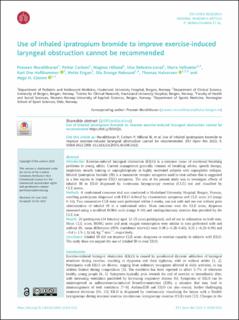| dc.contributor.author | Muralitharan, Praveen | |
| dc.contributor.author | Carlsen, Petter | |
| dc.contributor.author | Hilland, Magnus | |
| dc.contributor.author | Delestre-Levai, Irisz | |
| dc.contributor.author | Vollsæter, Maria | |
| dc.contributor.author | Hufthammer, Karl Ove | |
| dc.contributor.author | Engan, Mette | |
| dc.contributor.author | Røksund, Ola Drange | |
| dc.contributor.author | Halvorsen, Thomas | |
| dc.contributor.author | Clemm, Hege Synnøve Havstad | |
| dc.date.accessioned | 2023-04-13T10:26:12Z | |
| dc.date.available | 2023-04-13T10:26:12Z | |
| dc.date.created | 2023-02-19T14:49:12Z | |
| dc.date.issued | 2023 | |
| dc.identifier.citation | European Respiratory Journal Open Research (ERJ Open Research). 2023, 9 (1), . | en_US |
| dc.identifier.issn | 2312-0541 | |
| dc.identifier.uri | https://hdl.handle.net/11250/3062843 | |
| dc.description.abstract | Introduction: Exercise-induced laryngeal obstruction (EILO) is a common cause of exertional breathing problems in young adults. Current management generally consists of breathing advice, speech therapy, inspiratory muscle training or supraglottoplasty in highly motivated subjects with supraglottic collapse. Inhaled ipratropium bromide (IB) is a muscarinic receptor antagonist used to treat asthma that is suggested in a few reports to improve EILO symptoms. The aim of the present study was to investigate effects of inhaled IB in EILO diagnosed by continuous laryngoscopy exercise (CLE) test and classified by CLE scores. Methods: A randomised crossover trial was conducted at Haukeland University Hospital, Bergen, Norway, enrolling participants diagnosed with EILO defined by characteristic symptoms and CLE score ≥3 (range 0–12). Two consecutive CLE tests were performed within 2 weeks, one test with and one test without prior administration of inhaled IB in a randomised order. Main outcomes were the CLE score, dyspnoea measured using a modified BORG scale (range 0–10) and cardiopulmonary exercise data provided by the CLE test. Results: 20 participants (14 females) aged 12–25 years participated, and all ran to exhaustion on both tests. Mean CLE score, BORG score and peak oxygen consumption were similar in tests performed with and without IB; mean differences (95% confidence interval) were 0.08 (−0.28–0.43), 0.35 (−0.29–0.99) and −0.4 (−1.9–1.1) mL·kg−1·min−1, respectively. Conclusion: Inhaled IB did not improve CLE score, dyspnoea or exercise capacity in subjects with EILO. The study does not support the use of inhaled IB to treat EILO. | en_US |
| dc.language.iso | eng | en_US |
| dc.publisher | European Respiratory Society | en_US |
| dc.rights | Navngivelse-Ikkekommersiell 4.0 Internasjonal | * |
| dc.rights.uri | http://creativecommons.org/licenses/by-nc/4.0/deed.no | * |
| dc.title | Use of inhaled ipratropium bromide to improve exercise-induced laryngeal obstruction cannot be recommended | en_US |
| dc.type | Peer reviewed | en_US |
| dc.type | Journal article | en_US |
| dc.description.version | publishedVersion | en_US |
| dc.rights.holder | ©The authors 2023 | en_US |
| dc.source.pagenumber | 9 | en_US |
| dc.source.volume | 9 | en_US |
| dc.source.journal | European Respiratory Journal Open Research (ERJ Open Research) | en_US |
| dc.source.issue | 1 | en_US |
| dc.identifier.doi | 10.1183/23120541.00308-2022 | |
| dc.identifier.cristin | 2127301 | |
| cristin.ispublished | true | |
| cristin.fulltext | original | |
| cristin.qualitycode | 1 | |

